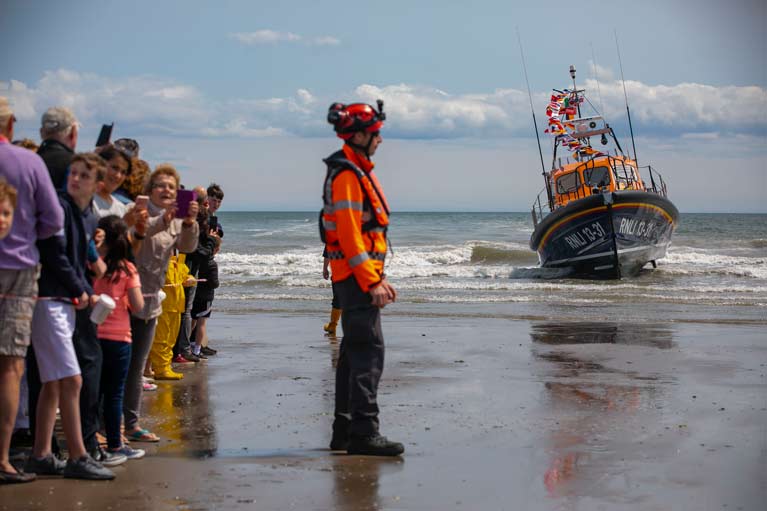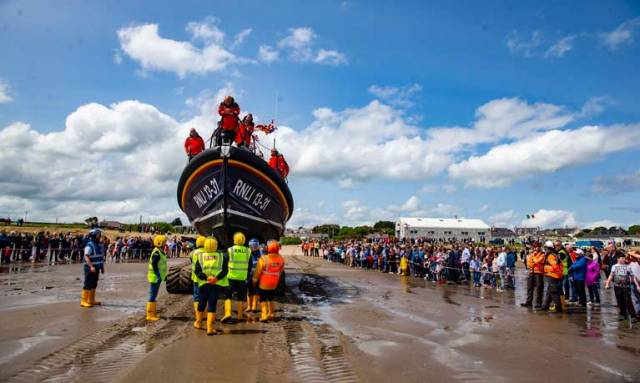The latest in RNLI lifeboat technology was delivered to Clogherhead in County Louth yesterday and was welcomed to its new home by hundreds of people who turned out from the town and surrounding areas. Clogherhead RNLI’s Shannon class lifeboat is unique in the RNLI’s fleet as it has been funded by an Irish legacy, named after an Irish lifeboat volunteer, designed by an Irish engineer and is the first class to be called after an Irish river. The Michael O’Brien Shannon class lifeboat arrived to a sunny Clogherhead at exactly 13.31 hours, the operational number of the lifeboat.
The Shannon lifeboat is the latest in a long line of boats provided by the RNLI to Clogherhead over the past 120 years. The €2.5 million lifeboat and its launching rig represents a major investment by the RNLI in the station and moves it from a 15-knot lifeboat to a 25-knot one, cutting vital minutes off the time it takes for the lifeboat crew to reach a casualty.
 The RNLI’s latest lifeboat arrives at Clogherhead, County Louth. The €2.5 million Shannon class lifeboat is jet driven and can be beached intentionally for recovery from the sea. Picture: Patrick Browne
The RNLI’s latest lifeboat arrives at Clogherhead, County Louth. The €2.5 million Shannon class lifeboat is jet driven and can be beached intentionally for recovery from the sea. Picture: Patrick Browne
A significant proportion of the funding for the Clogherhead lifeboat has been provided through a generous legacy by Wexford farmer, Mr. Henry Tomkins, who was a lifelong supporter of the RNLI. Henry stipulated that a lifeboat be named for his long-time friend, the former Arklow RNLI Coxswain, Mr. Michael O’Brien. The Shannon lifeboat was designed by Derry man Peter Eyre who as child was rescued by Lough Swilly RNLI in Donegal.
The new lifeboat arrived at Clogherhead after leaving Poole in Dorset earlier in the week. On its way to its new home the lifeboat crew stopped in Brixham, Newlyn, Milford Haven, Howth and Arklow, the latter as a tribute to the man who the lifeboat is named in honour of, former Arklow Coxswain Michael O’Brien. Approaching the beach at Clogherhead, the vessel was flanked by lifeboats from neighbouring RNLI stations, Howth, Skerries and Kilkeel, who created a flotilla for the watching crowds.
"It will also be the first time in Ireland that the RNLI will use a SLARS to launch & recover a lifeboat"
The new lifeboat is jet driven which gives the vessel increased manoeuvrability. It will also be the first time in Ireland that the RNLI will use a SLARS (Shannon Launch and Recovery System) to launch and recover a lifeboat. The SLARS acts as a mobile slipway for the lifeboat and has a unique turntable cradle, which can rotate the lifeboat 180º, ready to be launched again within ten minutes.
Clogherhead RNLI Coxswain Tomás Whelahan said, ‘ We were thrilled with the welcome we received on our journey home in our new Shannon class lifeboat. I want to thank the many people who came down to Clogherhead to see our arrival, which made it an incredibly special homecoming. We have had a great week with the new lifeboat, getting to know it and seeing what it can do on the open sea. It is a wonderful piece of kit, very different to our Mersey class lifeboat, faster and more technologically advanced.’
‘We are honoured to receive this lifeboat and very grateful to our donor Henry Tomkins and to the local communities, who by their generosity, have made this day possible. We hope to bring many loved ones safely home in this new lifeboat, the Michael O’Brien.’
































































